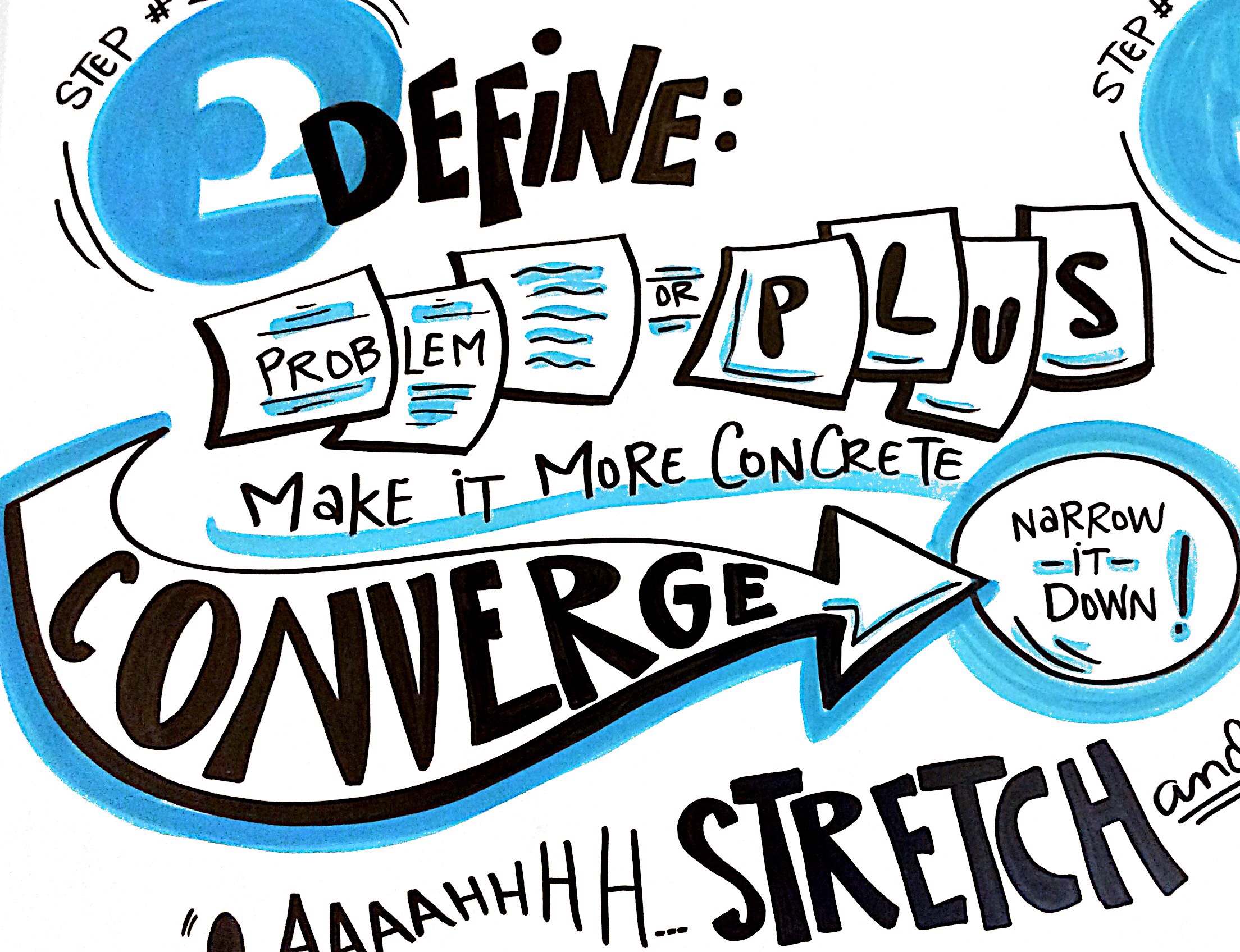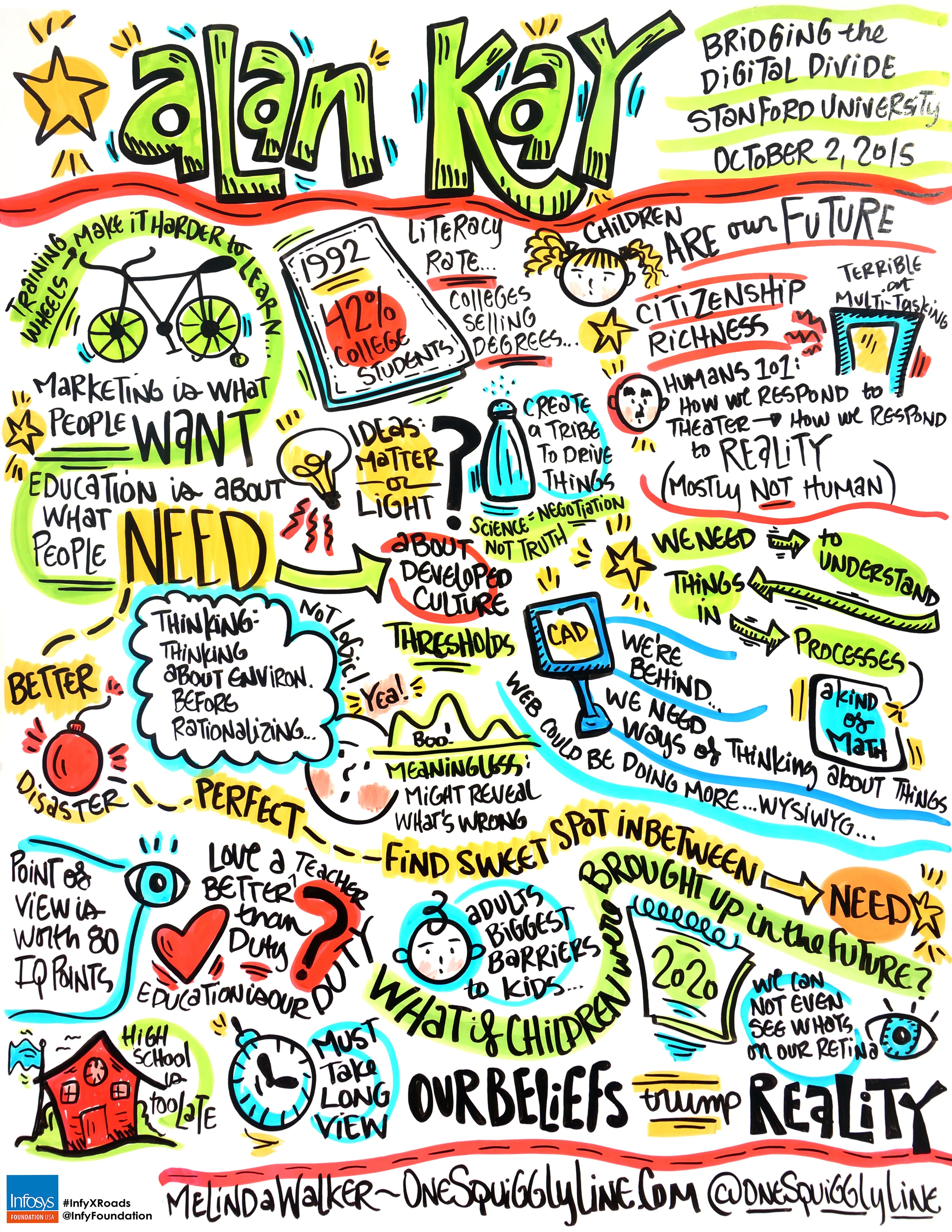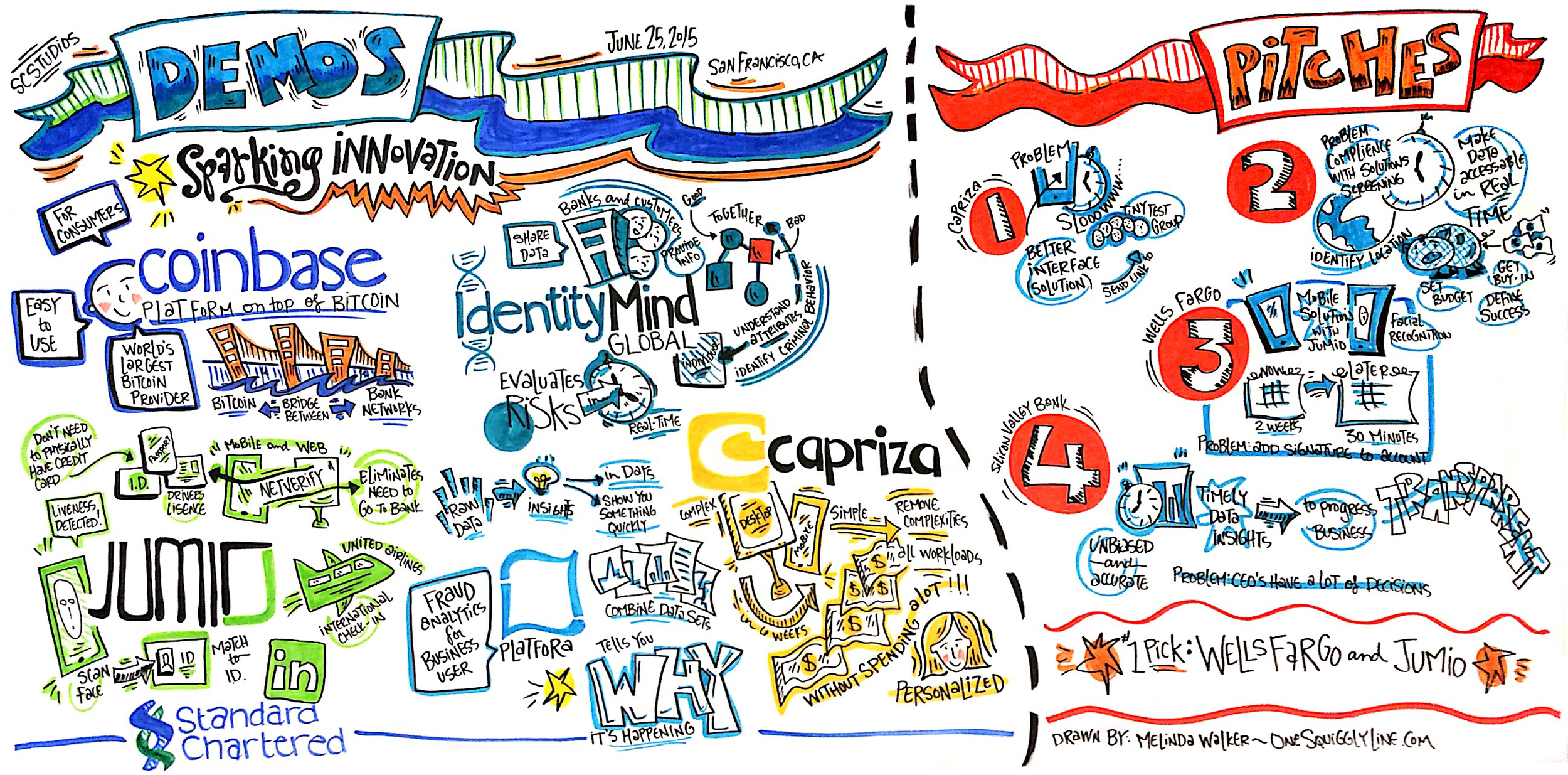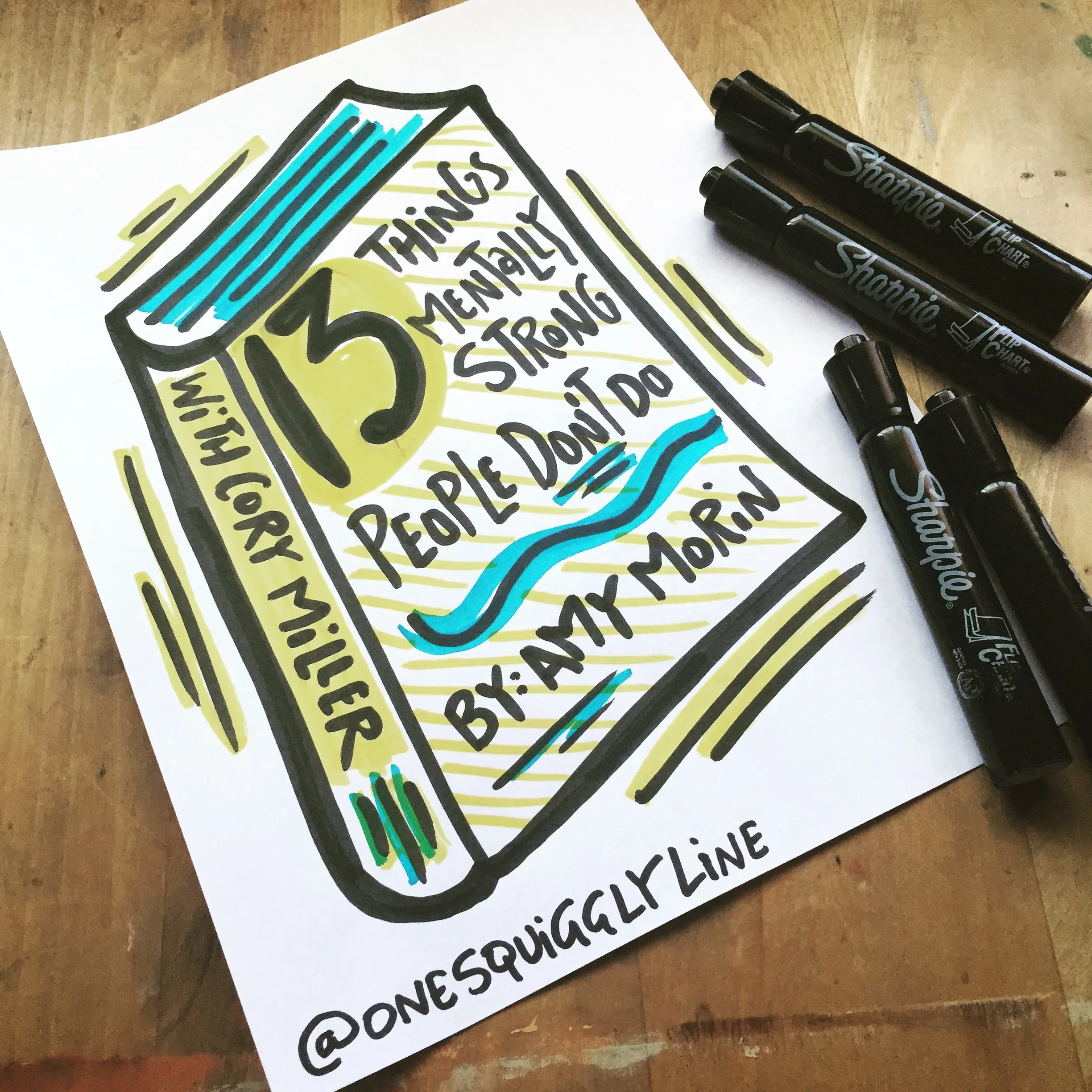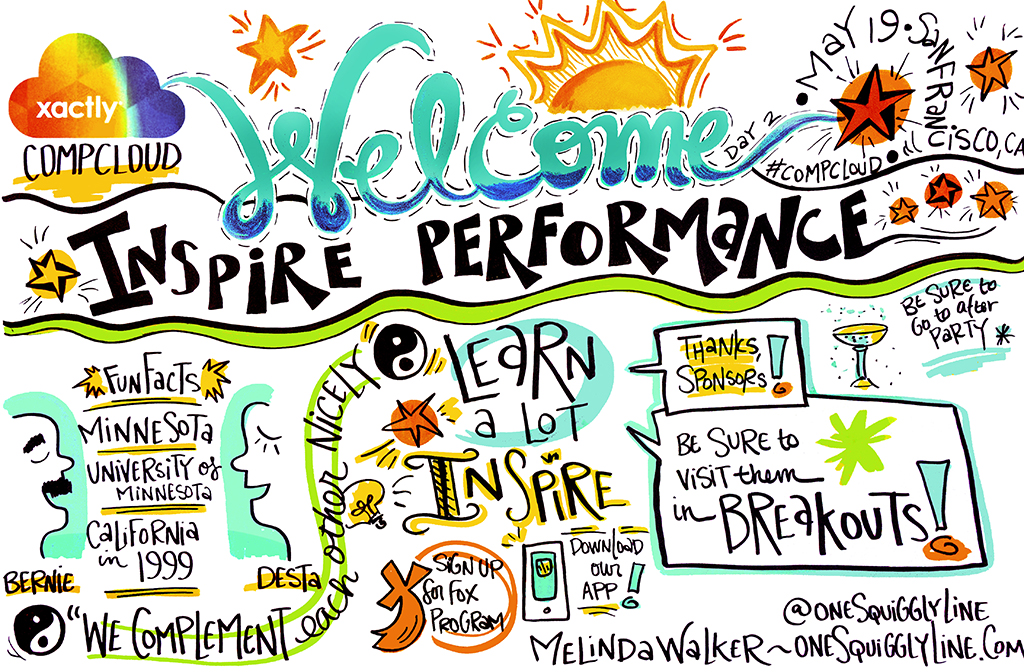People often think I do a lot of drawing while taking live visual notes. If you really look at the image above, you'll see there's really not much drawing there at all. Just some squares, a couple of circles, and an arrow. That's it!
When you write words inside simple shapes, those simple shapes start making your own notes a bit more visual. They become more dynamic. More interesting. The image and the message become more unified. And far more powerful.
A great way to make your own notes more visual is to write some of your words inside simple shapes — circles, squares, triangles, arrows, etc. Give it a try!
The image above is a close-up of a 4'x8' drawing, created live, in real-time during a Design Thinking workshop. Be sure to check out the entire image!
Visual Thinking & Visual Notes: Live Graphic Recording at Events
There's never just one way to create visual notes, especially when they are created live. And at a large scale. That can make capturing a panel talk more of a challenge for some people. It takes a bit more flexibility than a clearly defined presentation.
I tend to capture panel discussions in a way that highlights the key points of the discussion as a whole. Not a series of summaries of what each person contributed. Since discussions tend to be rather fluid, the final visual makes much more sense that way. Speakers tend to like it better that way, too. So often key points build on what another speaker said, so there's no chance of misattribution when you capture the discussion as a whole.
The visual notes above were created during a panel discussion at TechInclusion last fall. You can see the whole set of visual notes created live, on-site there in this Flickr album.
Visual Thinking & Live Visual Notes: Graphic Recording
When working live, you never know what's going to happen. I usually only have the same information the people in the audience have, which is a basic agenda. So I know the speaker's name, title of their talk, and how long they are scheduled to speak. That's it!
It's not uncommon for talks to go longer as planned, like the one above. That's usually a good sign, as it means the audience is really engaged. But it can be a challenge to capture all that extra content on the same page.
Color is a great way to keep things organized when there's not much space available. Grouping concepts and thoughts according to color allows you to have completely different ideas right next to each other without things getting confusing.
See more visual notes created live at One Squiggly Line's graphic recording page.
Visual Thinking & Live Visual Notes (Graphic Recording): Demos & Pitches
Demos and pitches are a pretty common part of the business world. Actually, they're a big part of every world, even if you don't formally use the term "demo" or "pitch". At the heart of both demos and pitches is a quick, concise presentation of key points. Hopefully, that presentation is both entertaining and memorable.
Hand-drawn visuals are a great way to make your presentation more entertaining and memorable. The drawing above was created live, in real-time as the speakers gave their demo or pitch.
To see more examples of visual notes create live, in the moment, visit One Squiggly Line's Live Graphic Recording page. Or for visuals created to highlight key points, created before or after a presentation or from print materials, see One Squiggly Line's Synthesis Images page.
Visual Thinking: Live, Large-Scale Visual Notes (Graphic Recording)
Awesome. Passion. Both very powerful, positive high-impact words. Notice the difference between reading those words in standard print here and seeing them used in a hand-drawn illustration above?
If you look closely at the above drawing with an analytical eye, you'll see there's really not much drawing there at all. Just a big orange heart and two smaller black ones. Plus a few lines here and there. That's it! Nothing fancy at all, yet much more powerful than those exact same words printed out in a computer-generated font. And even more powerful yet when you actually watch someone write them.
That's just a small sample of how powerful live, large-scale visual notes and graphic recording can be. Curious to learn more? Check out the One Squiggly Line's "Services" page for a lot of examples. Just imagine how much more powerful those images would be if you were right there, watching them being created live, right before your eyes!
Visual Thinking: Visual Notes & Graphic Recording - Short Talks in Tight Spaces
Having a graphic recorder create large-scale visual notes at your event can create quite an impact and make the content way more powerful. Sometimes, there's just not time or space to work at a super large scale. But size alone is not what makes the images so powerful. The power comes from the magic that happens when words and pictures are used together - like carrying a big box with both arms instead of just one.
The image above is one of eight created at TEDxBerkeley last month on 20"x30" foam core board. While much larger than a sketchbook, this size is still much smaller than the standard 4'x8' boards many graphic recorders use. Yet, the image is still quite powerful and creates quite an impact - and the smaller size is much easier to carry around!
Check out the whole set of visual notes from TEDxBerkeley 2016!
Visual Thinking: Webinars, Social Media & Real-Time Drawings
A lot of information and ideas that used to be shared in person are now being shared online. Surprising to some, hand-drawn visuals can still be created in real-time, even when the entire interaction is taking place through a screen. Hand-drawn visuals are especially powerful in these situations because they give a very personal touch.
Webinars are a great example. Most webinars have an accompanying slide deck, chat room, and Twitter hashtag to follow. While the slides may have some visuals, the are generally seen in a completely different context than the chat room or Twitter stream. And with a lot of people interacting through chat and social media, it's really easy for comments and insights to get lost.
When hand-drawn visuals are posted in real-time during your webinar, they immediately grab people's attention. They keep the conversation alive, even after the webinar ends, thanks to your webinar hashtag. And hand-drawn visuals allow others to interact with core nuggets of your content, even if they missed your webinar. That can make them want to learn more and lead them to join you at your next event.
Be sure to watch this 15 second video to see what I mean. It shows 12 visuals that were drawn and posted to social media in real-time during the main 45 minutes of a webinar. The last 15 minute were devoted to Q and A, which I did not cover, but certainly could have, if needed.
To take a closer look at the visuals and see them all at once, check out this Flickr Album.
Please keep in mind, these were all drawn and posted in real-time. That means there was only about 4 minutes to draw, photograph, and post each picture!
Graphic Recording: Welcome!
Friendly visuals can set the tone for the day! This graphic recording was created during the welcoming remarks at the CompCloud event last month here in San Francisco. This represents about a half an hour of content on one 40"x60" board. As you can see, there's some white space and the writing is fairly large.
The next blog post will show another visual from the same event created during a much longer session. As you'll see, the length of the session and amount of content covered impacts the overall look of the resulting graphic recording image.
Visual Notes: How to Choose Between Graphic Recording and Sketchnotes
Graphic recording. Sketchnotes. Visual notes. The terms are often used interchangeably. But there are some distinct differences. Graphic recording is usually done on flip chart or larger paper, foam core board, or white board, with the graphic recorder standing in front of the group. Sketchnotes are much smaller (think printer paper or a notebook) with the sketchnoter sitting down - mine are usually black and white, but they can also be in color, too. Visual notes is an umbrella term including both graphic recording and sketchnotes. At least that's how I define things.
If you're looking to hire someone to create visual notes for you, how do you know if sketchnotes or graphic recording is best for you?
Generally, if you're going to bring someone in to work in person with your group, graphic recording is the way to go. Part of what makes graphic recording so powerful is that everyone in the room can watch the image unfold along with the conversation. This continually draws people back into the content and keeps them engaged. When displayed after, the images allow people to literally see the big picture of the content and discuss it with those around them. This would happen on a much, much smaller scale with sketchnotes, simply because only a few people can look at them at the same time.
If you're looking for visual notes of a video or audio file, then sketchnotes would probably work best. Sketchnotes can be just as powerful as large graphic recording images when displayed online. If nobody will be around to watch the notes unfold and you're only interested in digital files, it really doesn't matter what size the original notes are.
The sketchnote above was created from an audio file for the online course The Business Soul Sessions.
Spot Illustration: A One Word Story
Spot illustrations are simple drawings that illustrate one simple concept or word. (That's how I define them, anyways!) Often, spot illustrations turn that concept or word into a simple story. And, as anyone in marketing, sales, communication, and pretty much any other type of business knows, stories are where it's at.
Stories grab attention and draw people in. They make people curious and give them a reason to care. They can bring personal meaning to technical explanations. Stories bring things to life. Even if only a tiny glimpse of the story is told.
That's what spot illustrations do. They bring things to life and give just a glimpse of a story. Enough of a glimpse to grab attention, draw people in, and make them curious enough to find out how the story ends.
Contact me to have some hand-drawn spot illustrations created especially for you!

